CREATE-ing tools to help students learn
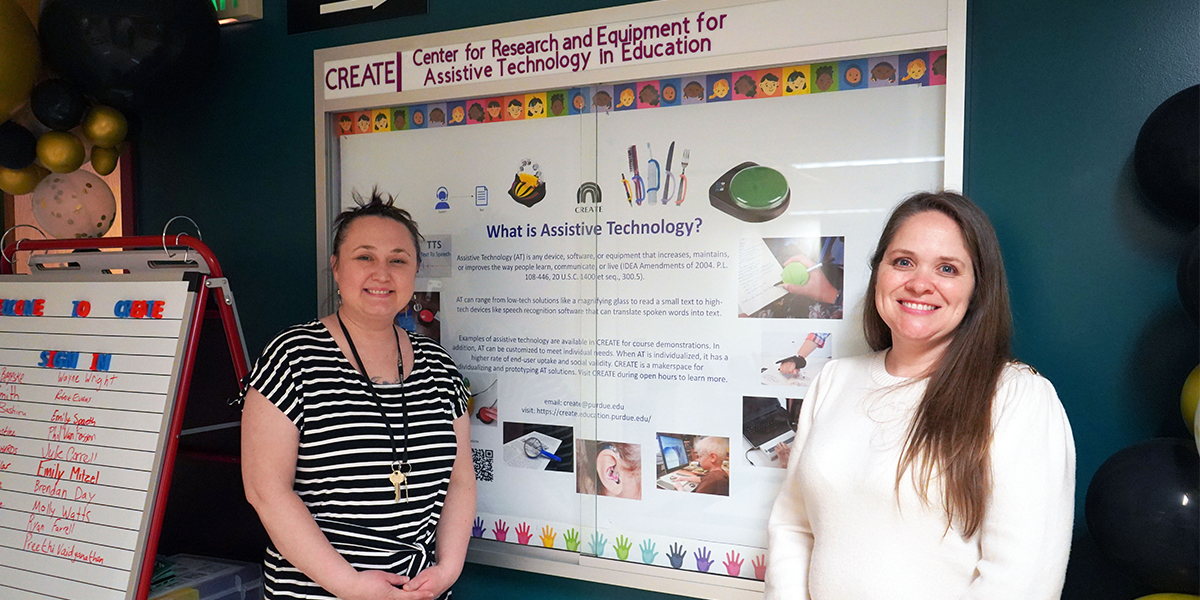
CREATE co-founders: Professors Jasmine Begeske (l) and Jennifer Smith (r) (Purdue University photo/DeEtte Starr)
Purdue approves College’s assistive tech research center
“All teachers need to know about assistive technology (AT),” said Jennifer E. Smith, clinical associate professor of special education in the Purdue University College of Education.
Smith is a founding co-director, along with colleague Jasmine Begeske, clinical assistant professor of special education, of the newly approved Center for Research and Equipment for Assistive Technology in Education (CREATE). They co-founded CREATE as a “makerspace” and assistive technology (AT) library in 2021 with $100K in funding via a Purdue Instructional Equipment Grant from the Office of the Provost. Purdue University recognized CREATE as an official research center in July 2024.
“The CREATE lab is a state-of-the-art resource that provides pre-service teachers at Purdue with real world experience with assistive technologies,” said Christine Kiracofe, head of the Department of Educational Studies, which houses the Center.
“Professors Smith and Begeske have put in significant effort in starting the center, and having CREATE named an official center by the Office of Research confirms the importance of the center’s work – to ‘promote accessibility and inclusion in education through innovative and effective interventions and research,’” said Phillip J. VanFossen, interim dean of the College.
It all started because Begeske and Smith love training the next generation of teachers and wanted to equip educators to better teach each and every student, including students in special education, with customized AT.

What is CREATE?
“CREATE is a place for teachers to create tools to help their students learn,” Begeske said. “We have lots of examples of assistive technology which are tools for living and learning, and we also have materials for making your own solutions.”
“CREATE is a place where students, teachers, and the community are able to create individualized assistive technology resources for the people they are working with,” Smith added. “We have pre-made AT, but we also provide a large amount of materials and tools for those interested in creating their own individualized resources. Those learning to be teachers can develop and hone their AT skills and others can expand their AT knowledge and skills.”
The Center’s mission is to promote accessibility and inclusion in education through innovative and effective interventions and research so that educators can provide high quality instruction for every student. Located in Beering Hall 3272, CREATE gives students and faculty access to both pre-made assistive technology and customized assistive technology solutions.

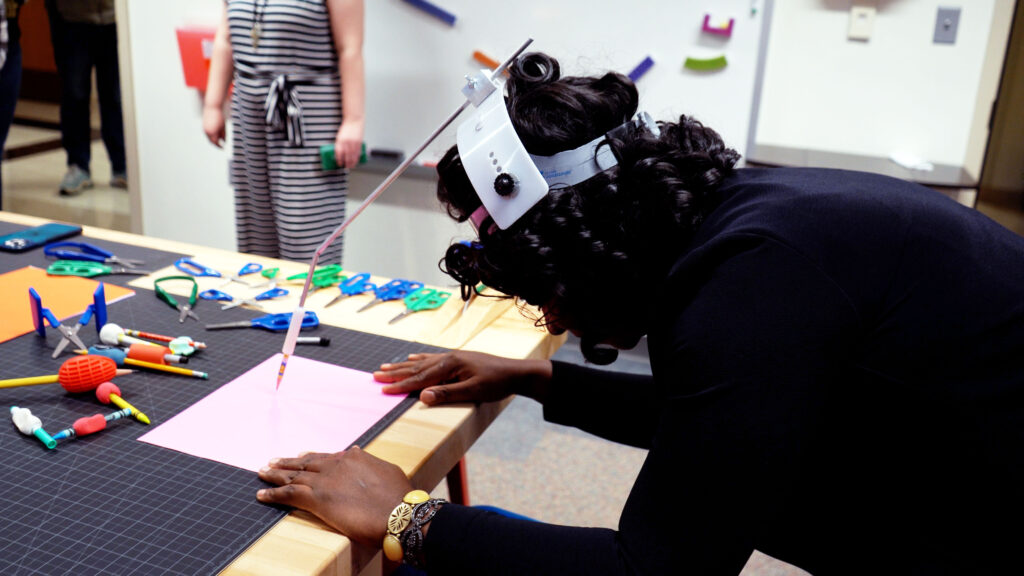
(l) Prof. Juliana Aguilar holding a communication board customized for a specific student;
Bashiru (r) using adaptive headgear to draw (Purdue University photo/DeEtte Starr)
How and why did CREATE get started?
“We applied for and were awarded the University Equipment Grant which has helped to fund CREATE,” said Begeske. “The original idea was that our supplies and equipment would be on mobile carts but the College has given us a permanent space on the third floor of Beering Hall.”
After receiving the equipment grant in 2021, Smith and Begeske spent about a year setting up the physical space in Beering 3272, with lots of help from their families. CREATE opened informally in the fall of 2022, mainly for College of Education students and teachers. In April 2023 CREATE held a Grand Opening for the public to celebrate, tour, and explore the facility and its assistive technology devices. The research center approval process took about two years, according to Smith.

(Photo provided by Jennifer Smith)
How does CREATE impact teacher education?
When CREATE first opened for Purdue students in fall 2022, Begeske held a Practicum in Strategies for Teaching Individuals with Disabilities (EDPS 461; now Student Teaching Semester 1) in the Center. The course focused on intensive interventions for students with disabilities. Her students had “field experiences” in local classrooms which served students with high intensity medical, physical, cognitive, and behavioral needs. Begeske gave each Purdue student an assignment to create a learning solution for their field experience classrooms.
“Students created communication boards and task boxes to teach pre-vocational skills, and adapted games to their students’ specific needs,” Begeske explained. “I was really proud that my students were able to make a real impact on accessibility in their classrooms when provided with the tools and space for making assistive technology.”
“I actively try to use CREATE in every single class I teach,” explained Smith, a 2024 Murphy Award winner. “In K-12 Reading for Exceptional Learners (EDPS 402), students learn how to make and adapt a variety of resources to use in their future classrooms – focusing on creating lower-cost solutions than typical pre-made assistive technology.”
In this course, Smith’s students actively learned how to make “whisper phones” from PVC pipes for students to be able to use to hear themselves reading without reading too loudly; created adapted pictures for students with low vision or who are blind; learned how to use a Braille Printer; and studied the importance of inclusive practices for all students. Using all of these resources, students then created their own set of AT stations and centers based upon the Science of Reading to use in their future classrooms.
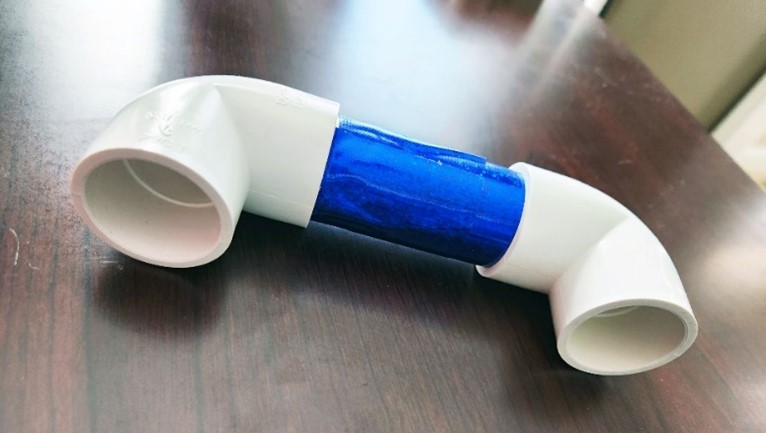
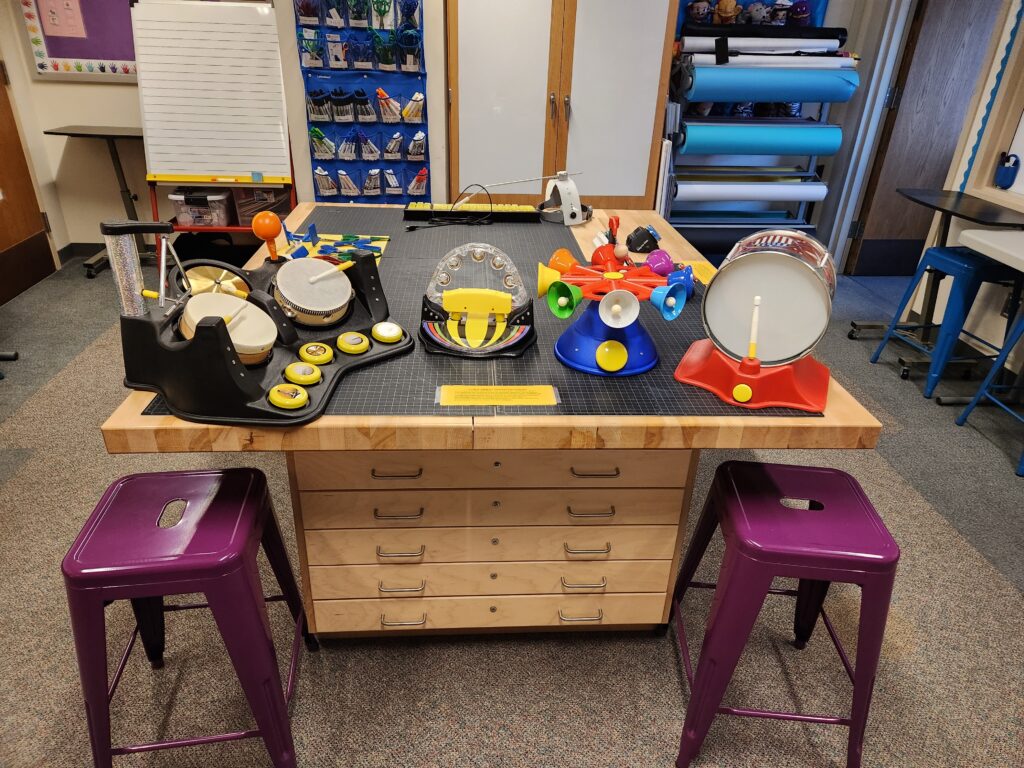
(l) A ”whisper phone” made of PVC pipe allows students to hear themselves while working on reading fluency – without distracting their classmates; (r) an array of adaptive musical instruments (Photos provided by Jennifer Smith)
Besides impacting Purdue students and the community, CREATE has impacted Begeske’s and Smith’s own children and families.
“My kids love to visit CREATE!” Begeske said. “My daughter always wants to make something when she’s in there. My son has played all of our adapted musical instruments and loves to figure out how to play our educational games. I think CREATE has helped my children to realize that teachers make things for their students and that we are problem-solvers.”
“CREATE not only makes my children think about the world in creative ways, but also they get to see their mom be passionate about helping others and thinking about innovative ways to make education and the world a better and inclusive place,” Smith said.
The lessons their children are learning are similar to ones that Purdue Education students are learning by using the Center.
What makes CREATE unique?
A key feature of CREATE is that “users can be inventors of technology rather than just consumers,” according to Begeske. The Center offers a poster printer, AT research, teaching, engagement opportunities, supplies, workspaces, and many other items to help educators create AT.
Multiple classes currently utilize the Center. Instructors may check out mobile carts to demonstrate assistive technology in their courses. Pre-service teachers also have access to check out resources and equipment for use with students in any field experiences. Faculty and graduate students across Purdue’s teacher education programs may use the Center to print posters for local, national, and international presentations, as well as check out pre-made AT or make their own AT to use in their courses. Community teachers may come in and create their own AT for specific students.
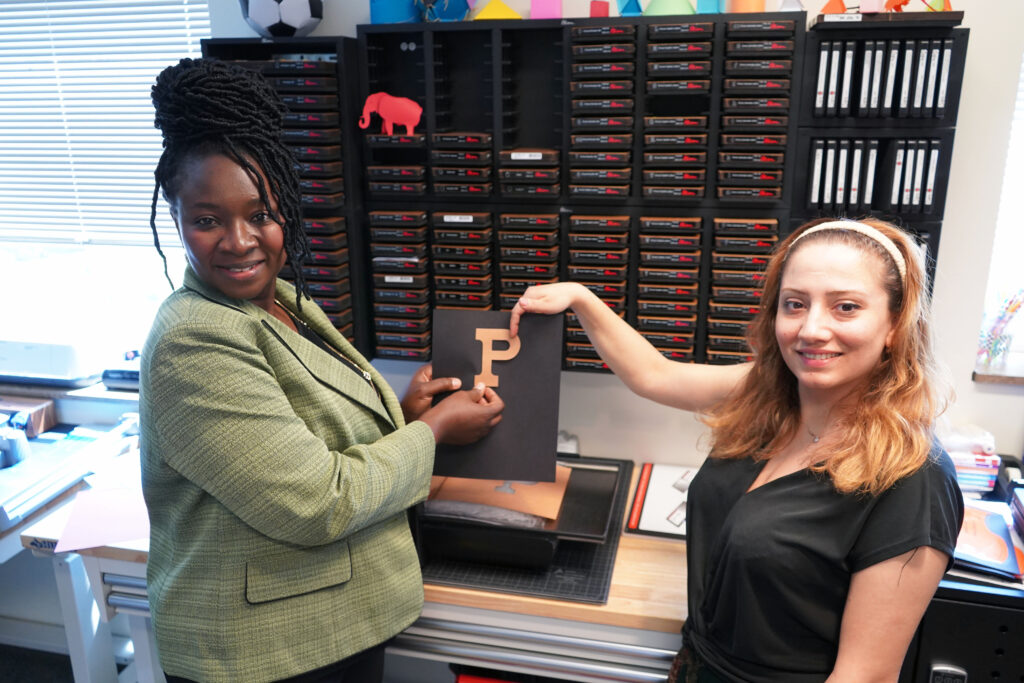
Inclusivity and practicality are some of CREATE’s highest values. The staff plans to work with the Accessible Creative Teaching and Inclusive Opportunities Now (ACTION) lab within CREATE, which does research on increasing inclusiveness within teaching and learning opportunities for learners of all abilities.
“We’re planning an assistive technology program assessment with ACTION to better understanding pre-service teacher knowledge and skills related to AT,” Begeske said.
What’s next for CREATE?
CREATE’s future is bright. “We plan to explore collaborating with other College of Education centers and institutes such as the Center for Advancing the Teaching and Learning of STEM (CATALYST), the Center for Literacy and Language Education and Research (CL2EAR), and the Gifted Education Research and Resource Institute (GER2I),” said Begeske.
Begeske and Smith hope to collaborate eventually with other Purdue research units including the Purdue Autism Research Center (PARC), Purdue Polytechnic’s BoilerMAKER Lab, the Bechtel Innovation Design Center, and the Purdue Polytechnic Institute.

CREATE is available to Purdue students and faculty — and community teachers interested in AT — during the semester in Beering Hall 3272 (check the CREATE website for open hours).
“CREATE is also a concrete example of the College’s commitment to preparing teachers to provide high quality instruction for each and every student, regardless of circumstance,” VanFossen said. “Introducing our pre- and in-service teachers to assistive technology, and to the benefits of innovative and effective interventions is an example of engagement that fills our land grant mission.”
Sources: Jasmine Begeske, begeske@purdue.edu; Jennifer E. Smith, smit3863@purdue.edu;
Contact CREATE: BRNG 3272, 765-494-5572, create@purdue.edu
Video tour: https://fb.watch/hpUKeR39WX/
Other CREATE news: CREATE: “All teachers need to know about assistive technology”